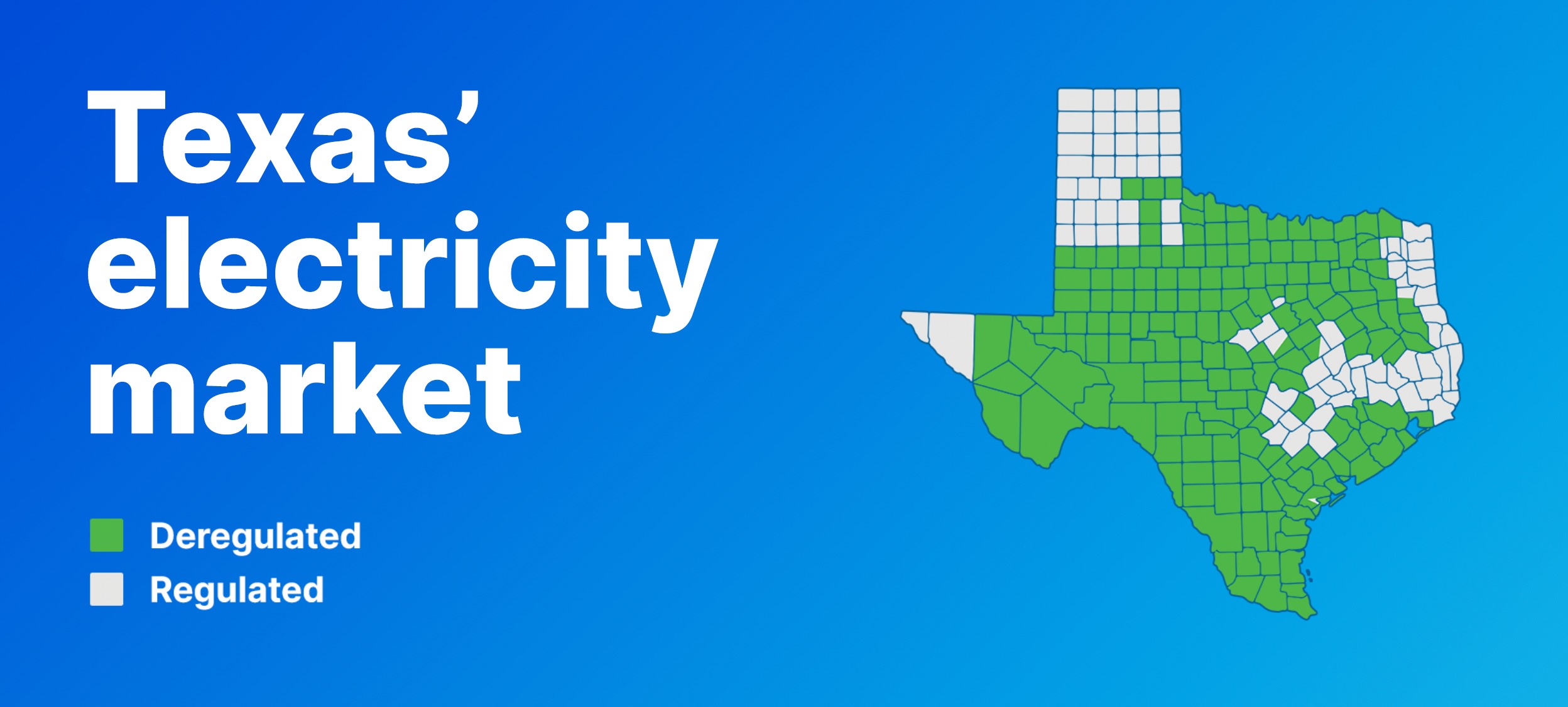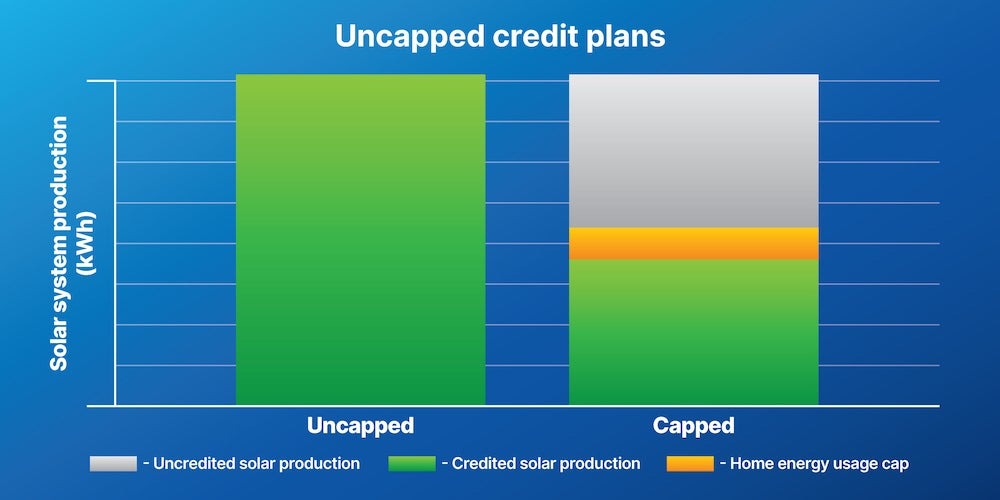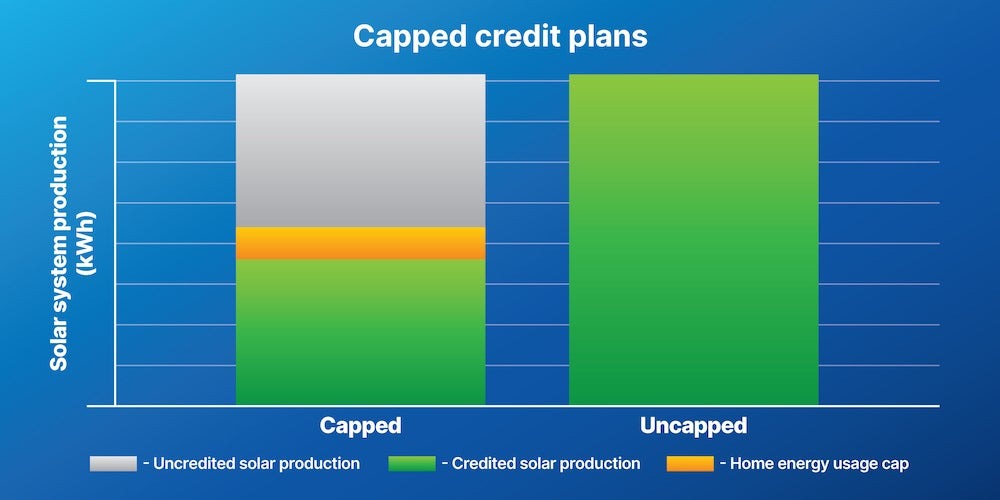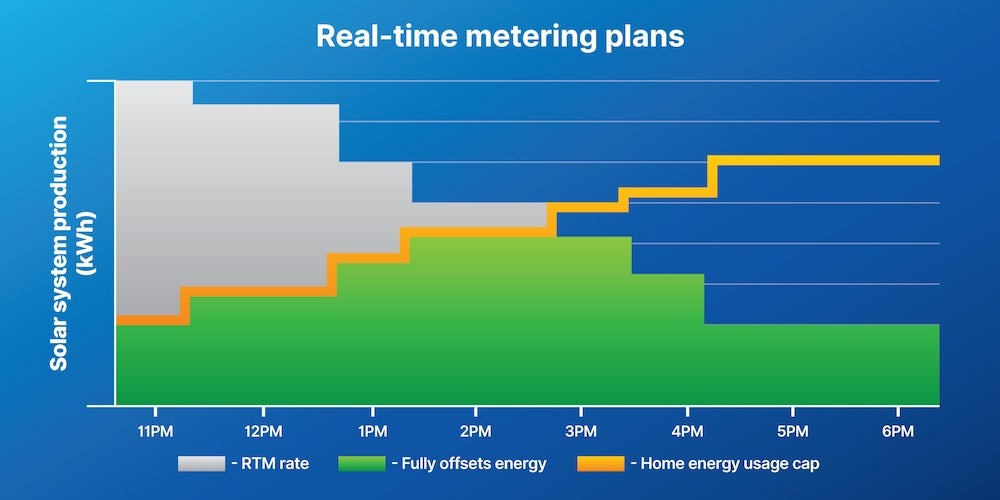Updated 3 months ago
Complete guide to Texas net metering: solar buyback plans, REPs & regulated utilities
Written by Catherine Lane Catherine LaneCatherine has been researching and reporting on the solar industry for five years and is the Written Content Manager at SolarReviews. She leads a dyna...Learn more

Why you can trust SolarReviews
SolarReviews is the leading American website for solar panel reviews and solar panel installation companies. Our industry experts have a combined three decades of solar experience and maintain editorial independence for their reviews. No company can pay to alter the reviews or review scores shown on our site. Learn more about SolarReviews and how we make money.
Despite being one of the fastest-growing solar states in the nation, Texas doesn’t have any statewide rules for solar net metering - the policy that saves homeowners money on their Texas electric bill by crediting them for excess solar energy their solar panels generate.
Instead, some retail electric providers and utility companies offer solar buyback programs for homeowners who go solar. But, the programs vary widely in how exactly they bill customers, and it can be difficult to navigate exactly what solar options are available to you.
Our solar experts identified three main types of solar buyback programs in Texas: uncapped credit plans, capped credit plans, and real-time metering plans. Of the three, uncapped credit plans can usually save solar homeowners the most money in Texas.
Our guide breaks down the specific details of the buyback plans in Texas and what you need to know to make the best decision possible when it comes to going solar.
Texas net metering at a glance
Texas does not have a statewide net metering policy, but seven retail electric providers, as well as many municipal utilities and electric cooperatives, offer some form of a solar buyback program.
If you live in a regulated area of Texas, you can only use the solar buyback plan offered by your utility company. Not all utilities offer solar programs.
Going solar in Texas is worth it for many homeowners, given they have access to a decent solar buyback program.
Texas’ electricity market

Before we get into the details about solar energy in Texas, we first need to clear up what's going on in the state’s electricity sector.
Around 85% of Texas participates in a deregulated electricity market, while the remaining 15% of the state participates in a regulated electricity market. Whether or not you live in the deregulated part of Texas will impact what you need to think about when going solar.
Deregulated Texas
With a deregulated electricity market, the supply of electricity is separate from the delivery of electricity. This presents a unique situation for solar homeowners in Texas that many homeowners in the rest of the United States don’t have to deal with.
The supply of electricity: Texans can shop around for electricity rate plans from different electric companies called Retail Electric Providers (REPs). If you want to go solar in the deregulated part of Texas, you’ll want to find an REP that has a solar buyback plan so you can maximize your solar savings. Whichever REP you choose will impact if solar will be a worthwhile investment for you.
The delivery of electricity: Even though you get to pick your REP when you live in a deregulated area of Texas, you do not have a choice over what Transmission and Distribution Utility (TDU) you have. The four TDU companies in Texas are:
The electric bill you receive from your REP will include REP electric charges, as well as TDU fees that get sent to the utility operating in your area.
Regulated Texas
If you live in an area that has a regulated electricity market, you do not choose an REP. Instead, your municipal utility or electric co-op will handle both the supply and delivery of electricity to your home.
So, the only electricity plans and solar buyback options you have are the ones offered by the utility company in your area.
Solar buyback rates offered by REPs in Deregulated Texas
Like we said before, if you live in a deregulated area of Texas, you’ll need to pick an REP. When you’re looking to go solar, you’ll want to narrow it down to REPs that offer solar buyback plans.
Out of the over one hundred REPs operating throughout the Lone Star State, only a handful offer solar buyback plans
But beware, not all of the solar buyback plans offered by these companies are created equal. We’ve divided the solar plans offered by these REPs into three categories:
1. Uncapped credit plans
2. Credit cap plans
3. Real-time metering plans
1. Uncapped credit solar buyback plans
Uncapped solar buyback plans will save the most money for solar homeowners in Texas because there is no limit on how much excess solar power the company will credit you for.

You see, there might be a few months out of the year when your solar panels produce more electricity than your home uses. When this happens, Pulse Power will pay you for that excess energy in the form of a bill credit, which can be carried over to help reduce your energy costs on future electric bills when your solar panels might not produce enough energy to cover all of your electricity needs.
The solar buyback credits are valued at the “energy charge rate”, which is the same rate Pulse charges you for the electricity you use from the grid. Keep in mind, though, electricity use from the grid will have additional TDU charges included.
These are not included in the solar buyback rate, however, which means your solar buyback credit will be worth slightly less than what you pay Pulse Power for each kilowatt-hour (kWh) of grid electricity.
2. Credit cap solar buyback plans
Like the name suggests, these REPs place a limit on how much solar energy the company will credit you for. These REPs all happen to have the same credit cap - you will not receive any credit for solar energy production that exceeds the amount of energy your home used during that month.

That’s a little confusing at first, but it’s easier to understand with an example. Let’s say your home used 500 kWh of electricity from the grid in one month. This means the maximum amount of solar energy your REP will credit you for is 500 kWh. Even if your solar system produces 700 kWh in a month, you will still only get 500 kWh in credits.
What about that extra 200 kWh of solar you produced? It just goes to the grid, and you get nothing for it. Because these plans limit how much solar energy the company will “buy” from you, you’ll get slightly lower solar savings than if you chose Pulse Power as your REP.
Just like with Pulse Power, these four REPs credit solar energy at the energy credit rate, which does not include any TDU charges. So, you pay a little more money for energy you take from the grid than what your solar energy gets credited for.
Money-saving tip: Consider installing a smaller solar system to minimize your excess energy! You don’t want to pay $18,000 to install a solar system that generates electricity you can't use or get paid for! A smaller system that covers all of your spring or fall usage won't eliminate all of your sky-high summer electricity bills, but it does cut down on the cost of your installation.
3. Real-time metering plans
Real-time metering (RTM) solar buyback plans operate a little differently than the other ones we discussed.

Real-time metering plans credit you on an instantaneous basis. This means at 12 PM when your solar panels produce 2 kWh more than your home needs, the REP is crediting you right then for those 2 kWh, instead of figuring out your net production at the end of the month. This wouldn’t really matter if the companies were crediting you at the energy credit rate, but they’re not.
Instead, instantaneous plans credit you for your excess generation at what the retail market price of electricity is at that exact moment. The retail market price of electricity fluctuates throughout the day, depending on factors like demand and where you’re located.
We can’t pin down exactly how much the retail market price of electricity will be, but it typically sits somewhere around $0.03 per kWh. There are extreme and rare cases where the real-time market price can be a couple bucks per kWh, which means your solar energy would be worth way more than what you pay, but these conditions are, like we said, extreme and rare.
So, what exactly does this all mean? Basically, because your solar generation is not netted against your energy consumption, the rate that the REP pays you for excess solar energy is generally going to be much lower than the rate you buy electricity for.
Which REP should you pick?
The right REP for you is going to depend on a ton of factors, including which REPs provide service in your area, the size of your solar system, what term length you’re looking for, and the amount of electricity you consume.
In general, you'll want to go with a REP that has low monthly base charges and electricity rates and doesn't limit the amount of solar energy it purchases form you.
You should look at what each REP is offering in your area and read the electricity fact labels they provide to get an idea of how much electricity will cost you.
Solar buyback plans for utilities in Regulated Texas
Going solar is a little more cut and dry for those who live in the 15% of the state that is regulated. Either your utility has some sort of solar buyback, or it doesn’t. If the plan is good, it’s good; if it’s bad, it’s bad.
Let’s take a look at just a few of these regulated utilities and what kinds of solar programs they offer:
1. CPS Energy’s solar buyback plan
If you live in the San Antonio area, you most likely get your electric service from CPS Energy. Even though you can’t choose which company you buy electricity from, the good news is CPS Energy does have a solar buyback plan called “net billing”.
Under its net billing plan, solar energy up to your home's monthly usage will be credited at the full-retail rate of electricity. Any solar energy produced that exceeds your home’s energy usage for the month will be credited at a lower rate.
San Antonio homeowners should consider going solar with CPS Energy sooner rather than later, as the utility’s board decided not to renew the solar incentive program, and net billing could be the next thing to go.
Utility | Plan | Import rate per kWh | Buyback rate at/below usage per kWh | Buyback rate above usage per kWh |
|---|---|---|---|---|
Net Billing | $0.13 | $0.13 | ~ $0.02 |
2. Austin Energy’s solar buyback plan
Austin Energy services the city of Austin, as well as some surrounding municipalities. The municipal utility has a different approach to solar billing than most utilities, not just in Texas but throughout the country.
Instead of crediting solar energy at the retail rate or the real-time market price, Austin Energy credits solar energy at the Value of Solar rate. The Value of Solar rate, or VOS rate as it’s sometimes referred to, takes many factors into account, like energy savings that solar provides to the utility, how solar can reduce stress on the grid’s transmission and distribution system, and the environmental benefits that home solar provides.
When you go solar with Austin Energy, you will have a meter that measures just your solar production and a separate meter that measures your home’s electricity consumption during the one-month billing cycle. Your electricity bill will also have two parts: the energy charges and the solar credit.
The energy charge will be equal to all of the electricity your home consumed, multiplied by the retail rate of electricity. The solar credit will be equal to all of the solar energy your panels produced, multiplied by the VOS rate.
If the solar credit is worth more than your total energy charges, the credit will roll over to the next month.
Utility | Plan | Import rate per kWh* | Value of Solar rate per kWh |
|---|---|---|---|
Value of Solar | $0.03 - $0.11 | $0.097 | |
Value of Solar | $0.03 - $0.11 | $0.097 |
*Varies by electric usage
Right now, the Value of Solar rate is higher than almost all residential electricity rate tiers, meaning your solar energy is worth more than grid energy! This makes going solar with Austin Energy a great investment.
Keep in mind, though, solar credits will not offset any taxes or fixed charges on your bill.
3. Brownsville Public Utilities Board’s solar buyback plan
Brownsville Public Utilities Board (BPUB) has over 52,000 total electric customers, and it offers its solar homeowners a solar buyback program similar to the real-time metering programs offered by Octopus and Shell Energy.
Your electric meter will read, in real-time, how much solar energy your solar panels are sending to the grid. That excess energy is valued at the Fuel & Purchase Energy Charge (FPEC), which you can find on BPUB’s website.
Utility | Plan | Import rate per kWh* | FPEC (Buyback rate) per kWh |
|---|---|---|---|
Solar buyback | $0.05 - $0.08 | $0.04 |
*Varies by electric usage
The structure of this program provides lower savings than some of the other utility programs in Texas, thereby making the investment in solar a little less lucrative with BPUB.
4. CoServ’s solar buyback plan
CoServ is an electric cooperative that operates across six counties in North Texas. Customers who want to go solar with CoServ can take advantage of the cooperative’s solar buyback program. It works just like the credit cap REP plans we described earlier.
CoServ will credit your solar energy production at the retail rate of electricity up to your monthly energy usage. CoServ will not provide credits for any solar electricity generated above your monthly usage.
Utility | Plan | Import rate per kWh* | Buyback rate below usage (per kWh) |
|---|---|---|---|
Solar buyback | $0.13 | $0.13 | |
Solar buyback | $0.11 - $0.13* | $0.11 - $0.13* |
*Varies by electric usage
5. Entergy Texas’ solar buyback plans
Entergy Texas has almost 500,000 electric customers across its service area, which spans 17 counties in southeastern Texas. Entergy offers three separate options for solar owners under its net metering program: Option 1, Option 2, and Option 3.
Under Option 1, Entergy will not purchase any electricity produced by your solar system. You would have one meter installed that measures your net electricity consumption, and if you sent any electricity to the grid, you’re not getting credits for it.
Option 2 will provide the best solar savings, as Entergy will purchase your excess solar energy. Keep in mind, it will be at the solar buyback rate, which is lower than the retail rate of electricity. This rate varies depending on the season.
With Option 3, Entergy will purchase all of the electricity your solar panels produce at that same solar buyback rate, which results in slightly lower savings than if you went with Option 2.
For more information about going solar with Entergy, check out our in-depth guide here.
Utility | Plan | Import rate per kWh* | Solar buyback rate |
|---|---|---|---|
Net Metering Option 1 | $0.10 | $0 | |
Net Metering Option 2 | $0.10 | $0.04 - $0.05 | |
Net Metering Option 3 | $0.10 | $0.04 - $0.05 |
*Based on Entergy’s residential service rider; Time of Use rates are also available
Should Texans consider solar batteries?
So, we know that most Texas homeowners don’t have access to a true net metering program, in which all solar energy is credited at the full-retail rate of electricity. Does that mean homeowners should get solar batteries to save extra money on their utility bills?
From a financial standpoint, solar batteries will technically save you additional money on your electricity bills. Instead of sending your excess energy to the grid and getting paid at a less-than-retail rate, you would store the energy in your battery and use it later, thus making all of your electricity worth the full price.
However, batteries are pretty expensive, around $10,000 at a minimum, so the amount of extra savings you’ll get probably won’t pay off your battery system, even with the federal solar tax credit.
With that said, you have to consider the other benefits of buying a solar battery besides the extra savings you may or may not see. For one, solar batteries let homeowners greatly decrease their independence on the grid. You don’t have to pay the utility as much money, and you get to use electricity that you produced right on your roof. Plus, it maximizes the amount of clean energy your home uses.
Perhaps the biggest selling point of solar-plus-battery storage is that you get to keep your power on during an outage. Having access to reliable backup power is a huge concern for Americans across the board, but for Texans especially.
Winter storms in recent years have caused prolonged blackouts because Texas’ utilities simply aren’t equipped to handle such low temperatures. A solar battery can give Texas homeowners peace of mind in these situations, which, for many, is priceless. If you're curious about solar batteries, our solar calculator gives you the option to see how a solar battery will impact your investment.
Are solar panels worth it in Texas?
There’s a reason why Texas’ solar energy industry is growing so quickly, and it’s not because people like spending tens of thousands of dollars for fun. It’s because installing a solar energy system can be a worthwhile investment for many Texans, and it's ultimately up to you how worth it it is.
Sure, everyone would like it if their REP or utility purchased their excess solar energy at the full retail rate, but that’s just not the case. That doesn't mean you shouldn’t go solar, though. Installing solar panels, even just enough to cover a majority of your energy usage instead of all of it, can save you hundreds of dollars a month. In fact, many Texas homeowners can recoup their investment in their solar panels in as little as 12 years!
And it’s not just about the energy bill savings - switching to solar gives you the ability to generate your own renewable energy right on your own roof. Why wouldn't you want to save money on your electricity bill while taking your energy freedom back from big companies?
It’s all about smart planning, picking the right REP (if you can), and working with the right installer. You can start your solar journey by using our solar calculator, which will give you an idea of what kind of solar savings you can expect based on your location and your most recent electricity bill.
Additional solar resources for Texas homeowners
Catherine has been researching and reporting on the solar industry for five years and is the Written Content Manager at SolarReviews. She leads a dynamic team in producing informative and engaging content on residential solar to help homeowners make informed decisions about investing in solar panels. Catherine’s expertise has garnered attention from leading industry publications, with her work being featured in Solar Today Magazine and Solar ...
Learn more about Catherine Lane